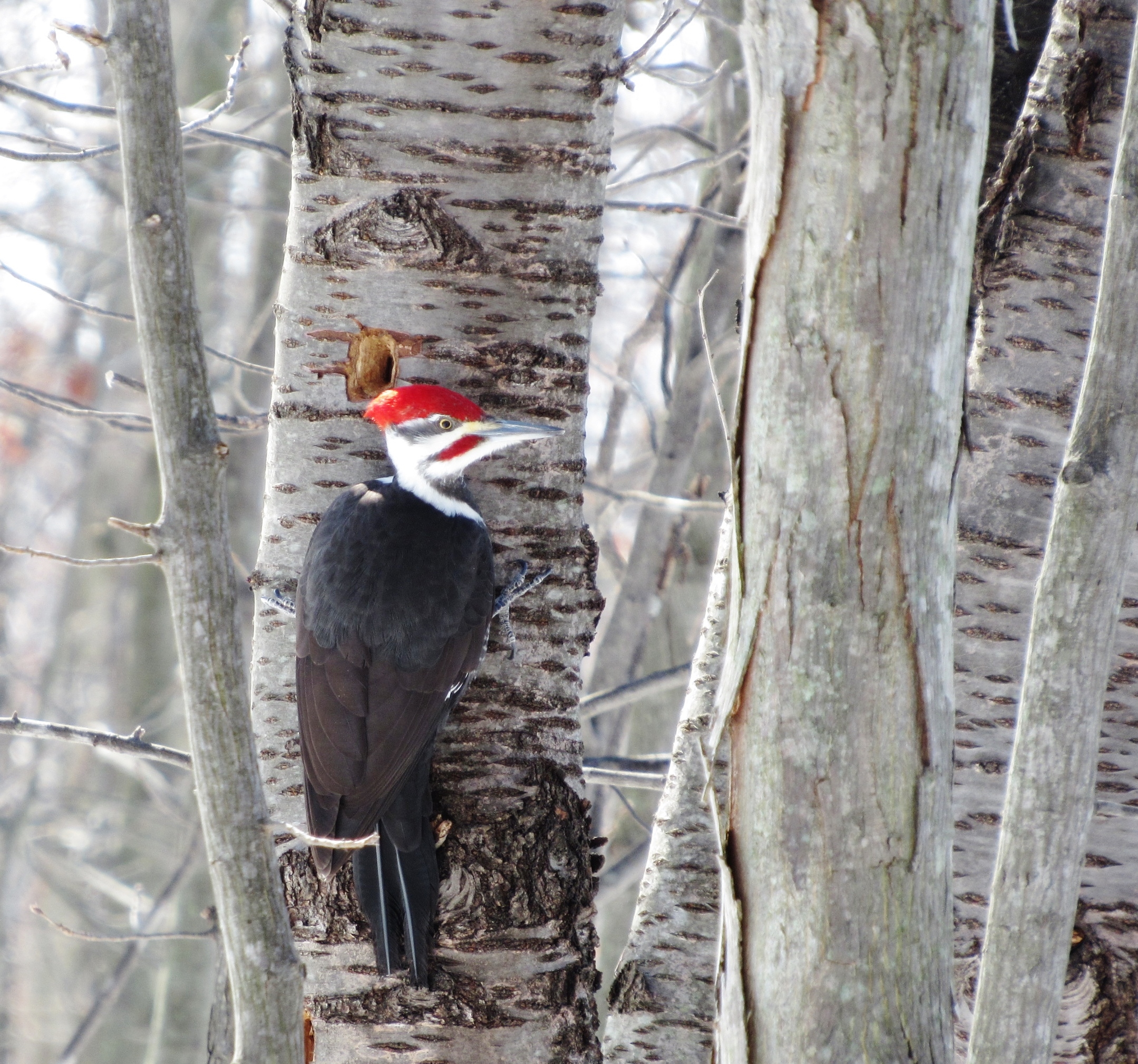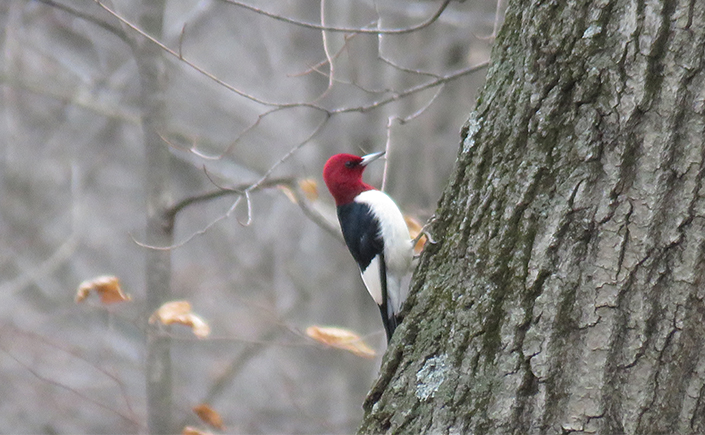WILDER SIDE OF OAKLAND COUNTY
As the hours of daylight lengthen in these early days of March, the woods become alive with early morning songs and the rhythmic drumming of woodpeckers proclaiming territory and taking part in their spring courtship rituals. Most of those woodpeckers go unnoticed by unsuspecting human eyes. That is, of course, with the exception of woodpeckers that frequent feeders filled with suet, or perhaps discover, much to the chagrin of the homeowner, that drain pipes and metal trim on homes are places where the resonance is best.

March is also the month that I often hear a repeated question, “What kind of woodpecker has a red-head?” That’s a tough question to answer easily for the phrase “red-head” means different things to different people. Only one North American species of woodpecker truly has a red-head, and that honor goes to the Red-headed Woodpecker (Melanerpes erythrocephalus), perhaps the most uncommon woodpecker of Oakland County. Four other woodpecker species in Oakland County have red caps, but that does not make them Red-headed Woodpeckers.

The bold red, white and black coloration pattern of the Red-headed Woodpecker is unmistakable. Here’s how it’s described by the Cornell Lab of Ornithology, “The gorgeous Red-headed Woodpecker is so boldly patterned it’s been called a ‘flying checkerboard,’ with an entirely crimson head, a snow-white body, and half white, half inky black wings. These birds don’t act quite like most other woodpeckers: they’re adept at catching insects in the air, and they eat lots of acorns and beech nuts, often hiding away extra food in tree crevices for later. This magnificent species has declined severely in the past half-century because of habitat loss and changes to its food supply.” I had a chance encounter with one of these beauties last week that set me out on a foot chase over hills and between dead ash trees and stately oaks to try to capture images.

It’s not easy to chase a woodpecker. It’s foolish. It took about two hours of fruitless, but fun, searching before sensibility reached me. I thought to myself, stop searching, start thinking, find a place to sit. If I waited quietly, perhaps I’d get better images than my first few blurry ones. And so that’s what I did on the southern slope of a wooded hill, overlooking a marsh.

That woodland looked like prime woodpecker habitat. After just a few minutes of sitting and listening to the chatter of chickadees that took note of my presence, I spotted not just one Red-headed Woodpecker, but three separate individuals. The flight of the first one drew my attention, with flashes of black and white as one of these “high-contrast” woodpeckers flew between oaks and came to rest on a dead ash tree barely fifty feet in front of me. Two were adult birds with the characteristic bright red-head and brilliant white wings that are most noticeable when in flight. The third one was puzzling, its flight pattern, white wings and body color said Red-headed Woodpecker, but there were dark brown patches on its head mixed with splashes of dull red. A bit of research revealed that young Red-headed Woodpeckers molt into full color by their second year, but often have an odd patchwork of gray, brown, and red plumage on their heads well into their first winter.

My Red-headed Woodpecker encounter did not happen in Oakland County, but at Pokagon State Park in Angola, Indiana, where I was attending a Great Lakes Park Training Institute conference. Perhaps I should add that woodpecker hunting was not on the official agenda. However, a tree-hugging, nature-loving nature writer cannot sit inside at academic sessions all day. The Cornell Lab of Ornithology might as well have been describing the glacially sculpted landscape of Pokagon State Park when they described Red-Headed Woodpecker habitat this way on their website, “Red-headed Woodpeckers breed in deciduous woodlands with oak or beech, groves of dead or dying trees, river bottoms, burned areas, recent clearings, beaver swamps, orchards, parks, farmland, grasslands with scattered trees, forest edges, and roadsides. During the start of the breeding season they move from forest interiors to forest edges or disturbed areas.”

Upon returning to my home base in Oakland County, I searched for more information on the Red-headed Woodpecker and discovered they store food under bark and in cracks of wood, and not just seeds and nuts; live grasshoppers are included in the mix. One of my Indiana images, upon close inspection, reveals a Red-headed Woodpecker removing a grub from a crevice in tree bark, something I did not notice when taking that photograph. I suspect that the devastation of the ash trees in Oakland County may provide new foraging opportunities for our Red-headed Woodpeckers and slowly increase their numbers in our county. That brings us back to the original question: “What woodpeckers have red heads?” None, except for the Red-headed Woodpecker, is the correct answer, but four other rather common woodpecker species have red caps or red crests.

The most common one is the Downy Woodpecker (Picoides pubescens), the smallest North American woodpecker and a common visitor to suet feeders. They are only about six-inches long and thrive across Oakland County. The males and females of the diminutive downy look very much the same, but the males have a bright red patch on the back of the head. On the females, that patch is black.

The Hairy Woodpecker (Picoides villosus) looks almost exactly like its smaller downy woodpecker cousin, but hairy woodpeckers are larger and their bills are longer. The male hairy woodpecker, like the downy, sports a red cap on the back of its head.

Photo Credit: Jeff Nedwick
Red-bellied Woodpeckers (Melanerpes carolinus) are rather common in the interior of many of our woodland parks, and like the downy and hairy, frequent feeders with suet. The name red-bellied comes from what is described rather accurately by avid birders as a “red-smudge’ on the lower abdomen. It’s often difficult to see, but a patient observer knows if they wait long enough, and are in the right position, it will be visible. The males have a noticeable bright red patch that runs from the bill across the crown to the back of the head. The females only have a red at the base of their bill and at the back of their head.

The Pileated Woodpecker (Dryocopus pileatus) is the largest woodpecker in North America. I agree with nature writers that proclaim it’s the most striking forest bird of the continent. It’s a big woodpecker with a wing span of more than two feet. They are becoming increasingly common in the woodlands of Oakland County, especially in our expansive State Recreation Areas, managed by the Michigan Department Natural of Resources. They are also seen along The Paint Creek and Polly Ann Trail and in parks managed by Oakland County Parks and the Huron Clinton Metropark Authority, especially Addison Oaks County Park, Independence Oaks County Park, Orion Oaks County Park, Indian Springs Metropark, Stony Creek Metropark and Kensington Metropark. Both the male and female Pileated Woodpeckers have flaming-red crests on their heads and the males also have a bright stripe of red along their cheek. But are they Red-headed woodpeckers? The answer is no. We only have one red-headed species of woodpecker in Oakland County and that’s the Red-headed Woodpecker.

Jonathan Schechter is the Nature Education Writer for Oakland County, Michigan Government and blogs weekly about nature’s way, trails, and wildlife on the Wilder Side of Oakland County.
Looking for Oakland County news and events? Visit our website and follow along with us on Facebook, Twitter, Instagram, Pinterest, and YouTube using #OaklandCounty.


[…] Red-Bellied Woodpecker sounded off near the swamp with its shrill kwirr, kwirr, kwirr call. The abundance of dead ash […]
Canton township. Total red head, black and white pokadotted back my back deck off of Cleveland Way. Canton Michigan.
Your comment somehow slipped through the cracks, so sorry on terribly delayed response. If it had a totally red head , you found one! Excellent . And hopefully you will see it more.
On March 4 we spotted a red-headed woodpecker not far from the Nature Center at Kensington Metropark. We were on the Deer Run trail, near the long boardwalk crossing the marshy area. We noted at the time that we rarely see these, and your article showed us that the red-heads are indeed uncommon here. Thanks for the interesting article and photos!
Hi Isabel,
I just noticed your comment on the red headed woodpecker. Great you saw one. I meander on the Deer Run Trail now and then, so I will keep my eyes open. And thanks for sharing you find!
Jonathan